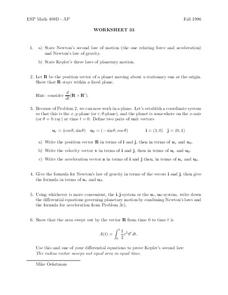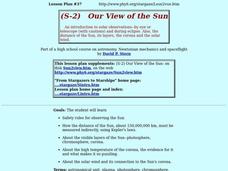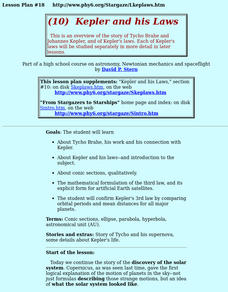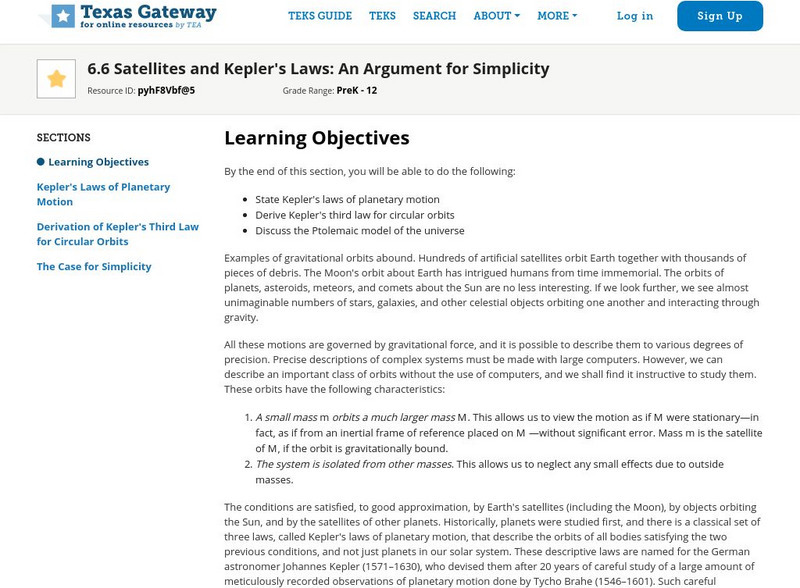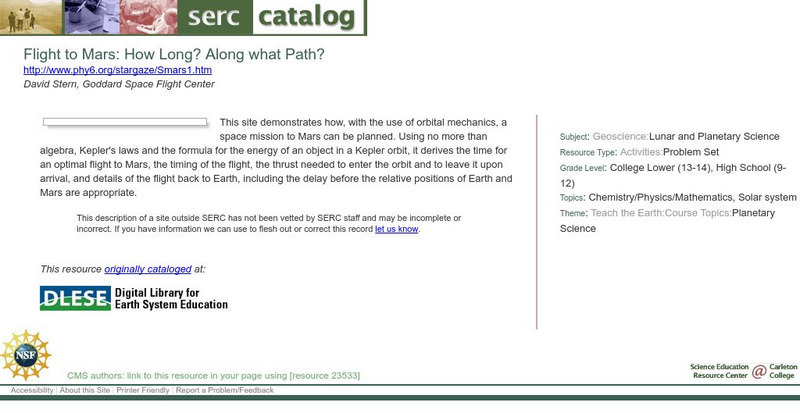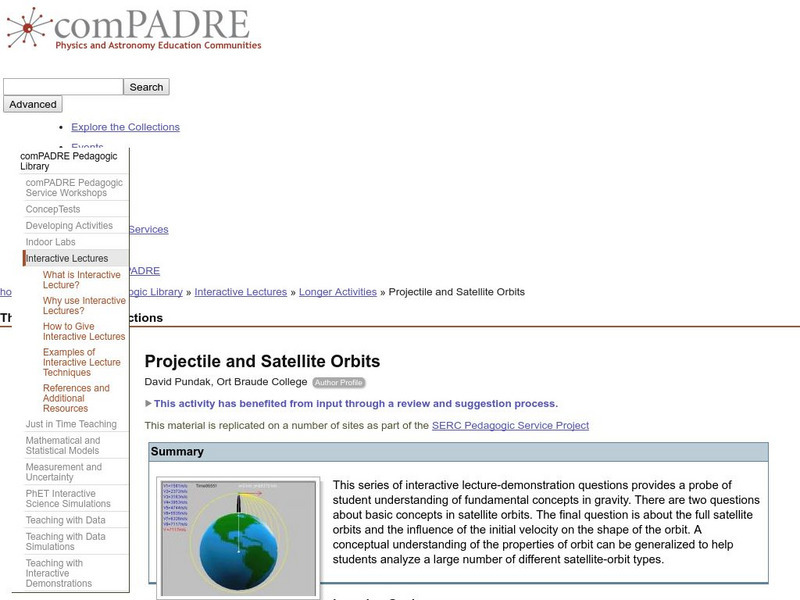Curated OER
Johannes Kepler
In this online interactive history worksheet, students respond to 10 short answer and essay questions about the achievements of Johannes Kepler. Students may check some of their answers on the interactive worksheet.
Curated OER
People of the Scientific Revolution
In this Scientific Revolution worksheet, learners read a brief overview of the contributions of Copernicus, Bacon, Kepler, Galileo, Newton, and Harvey.
Curated OER
Homework on Kepler's Laws of Planetary Motion
In this Kepler's Law worksheet, students answer questions given a diagram of the orbits of two planets about the sun. They use Kepler's Three Laws of Planetary Motion to answer the questions.
Curated OER
Kepler's Laws Review
In this Kepler's Laws worksheet, students answer questions about Kepler's three specific laws. They identify what the Elliptical Orbit Law, the Equal Area Law and the Harmonic Law mean.
Curated OER
Worksheet 33
In this math worksheet, students state Newton's second law of motion and his law of gravity. Then they state Kepler's three laws of planetary motion.
Curated OER
Our View of the Sun
Students are introduced to safety rules for observing the Sun, how the distance of the Sun is measured using Kepler's Laws and identify the visible layers of the Sun. They discuss solar eclipses and view images of eclipses using the...
Curated OER
Kepler And His Laws
Students engage in an overview of the story of Tycho Brahe and Johannes Kepler, and of Kepler's laws. Each of Kepler's laws be studied separately in more detail in later lessons. They examine Kepler's 3rd law.
Curated OER
Lesson Plan on Kepler's Laws of Planetary Motion
Students construct a solar system model. In this space science lesson, students calculate the eccentricity of a planet's orbit. They calculate the period of a planet's revolution using Kepler's formula.
Curated OER
Universal Gravitation and Kepler's Laws
Learners develop problem-solving strategies dealing with Kepler's laws of planetary motion. they examine the law of universal gravitation and continue with problem-solving strategies. Students complete a take-home quiz.
Curated OER
Mars: Off the Charts--Until You Put It There
Learners explore the night sky and make illustrations which are shared in class the next day. Distinctions are made between the stars and the planets and views of the constellations for the season are made available. The work of early...
CK-12 Foundation
Ck 12 Exploration Series: Simulations: Physics: Journey to Mars
[Free Registration/Login Required] Learn about Kepler's Laws of motion by planning a trip to Mars using a Hohmann transfer orbit.
American Association of Physics Teachers
Com Padre Digital Library: Open Source Physics: Kepler System Model
This site from Open Source Physics offers a file with a simulation of Kepler's theory of planetary motion, tested with the Earth rotating around the sun and another planet of the user's choosing. The download requires Java.
CK-12 Foundation
Ck 12: Kepler's Laws of Planetary Motion
In this online lesson students will learn the impacts of the scientific contributions of a variety of historical and contemporary scientists on scientific thought and society.[Free Registration/Login may be required to access all...
OpenStax
Open Stax: Satellites and Kepler's Laws: An Argument for Simplicity
In the following interactive students will begin to understand the laws of Kepler regarding planetary motion and derive the third law of Kepler for circular orbits. They will also discuss the Ptolemaic model of the universe.
Texas Education Agency
Texas Gateway: Gravity Understanding
In this learning module students can get a better understanding of how gravity affects our solar system.
Yale University
Open Yale Courses: Fundamentals of Physics
Intended for students with a strong math and science background, a course introducing physics concepts of Newtonian mechanics, special relativity, gravitation, thermodynamics, and waves. Twenty-four class sessions in video format are...
Texas Education Agency
Texas Gateway: Uniform Circular Motion and Gravitation: Problems and Exercises
This page offers a list of 50 problems/exercises to solve based on the content of Chapter 6: Uniform Circular Motion and Gravitation from the AP Physics online text.
Texas Education Agency
Texas Gateway: Satellites and Kepler's Laws: An Argument for Simplicity
By the end of this section, you will be able to state Kepler's laws of planetary motion, derive Kepler's third law for circular orbits, and discuss the Ptolemaic model of the universe.
Exploratorium
Exploratorium: Your Age on Other Worlds
How old would you be on Mars? Venus? Have fun plugging in your birthdate to see your age on other planets then read scroll down for a full explanation.
Massachusetts Institute of Technology
Mit: Open Course Ware: Orbits of Planets and Satellites
Students explore orbits of planets and satellites. Some topics examined in the activities are planetary motion, angular momentum of orbits, and Kepler's laws. The resource consists of video clips, lecture notes, practice problems, and...
NASA
Nasa: Kepler and His Laws
This site from NASA provides biographical details about the lives of Tycho Brahe and Johannes Kepler. Discusses Kepler's successes at developing laws of planeatry motion. States the three laws and discusses each one individually....
Texas Instruments
Texas Instruments: Multiple Choice Planetary Motion Study Cards
Kepler's Laws 1,2,3 including eccentricity of elliptical orbits. Good for reviewing planetary motions (NYS Earth Science).
Science Education Resource Center at Carleton College
Serc: Flight to Mars: How Long? Along What Path?
Demonstrate how, with the use of orbital mechanics, a space mission to Mars can be planned. Using no more than algebra, Kepler's laws and the formula for the energy of an object in a Kepler orbit, the exercise derives the time for an...
Science Education Resource Center at Carleton College
Serc: Projectile and Satellite Orbits
This activity introduces gravity and Kepler's Laws and helps to develop an understanding of gravitational force, satellite orbits, and their dependence on the initial velocity.






